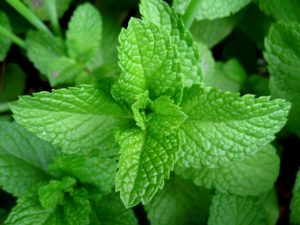Author – Katie Chriest
From Scarborough Fairgoers to Belfast balladeers, herbs have earned the love of lyricists as well as culinary artists for years. Their good looks and great flavors inspire all sorts of creative expression, and they’ve even enjoyed a resurgence in products promising to promote health.
No wonder, then, that they’re so widely cultivated. “People are hungry for herbs and herb products and we haven’t even begun to reach the full potential of what can be offered,” writes Jeanine Davis, an extension specialist at NC State.
“Fresh herbs are high value crops,” add Gary Gao and Brad Bergefurd in the Journal of Extension. “There is a good potential for small-scale farmers to generate a substantial amount of income from limited acreage by growing culinary herbs.”
And as palates diversify, foodies proliferate and holistic healers get certified by the minute, the market just keeps growing. But so does the pest pressure.
Compared to many crops, herbs are relatively easy to grow, with fewer insect pests. In fact, they’re often recommended as companion plants for other crops, since they’re believed to deter several common insects.

Unfortunately, though, some herbs are also “a true love of” lepidopteran pests—or caterpillars, the larval form of moths and butterflies.
Lepidopteran pests tend to feed on leaves. And leaves tend to be the delicious part of herb plants that we likewise devour. Consequently, herbs have a low threshold for caterpillar damage. It doesn’t take many chomps out of a leaf to render an herb plant unmarketable.
Take parsley, dill and fennel, for example. According to University of Maryland Extension, these herbs “are some of the host plants of the black swallowtail caterpillar. They can have voracious appetites. But because these caterpillars turn into black swallowtail butterflies, a native butterfly to most of the eastern United States and beyond, the damage is often tolerated. One solution is to plant extra so there will be enough herbs for you and for the caterpillars.”
Planting extra of your desired herb or including plants in your garden that could also attract these pests is good advice for home growers. And backyard gardeners may even get some entertainment value out of hand-picking pests off of each suffering plant and devilishly dropping them into a bucket of soapy water. Nevertheless, these methods simply are not feasible for commercial growers.
The sort of leaf destruction leveled by lepidopteran pests cannot be absorbed on a larger scale. In fact, losses of up to 80 percent have been documented during high pest populations.
But thanks to recent actions by IR-4, emamectin benzoate may now be incorporated by herb growers to specifically control lepidopteran pests.
“The use of a pesticide that attacks the specific pest that you’re looking to control makes it good for IPM programs, so that you’re minimizing the impact on your growing environment by just targeting those harmful insect pests,” explains Ken Samoil, a research coordinator and study director in the registrations team at IR-4 headquarters.
While few of the insecticides previously registered provided sufficient control during infestation peaks, emamectin benzoate, which has a different mode of action than the other pesticides, will also prevent insecticide resistance among armyworms and other pests.
“Armyworms get their name from their behavior of moving across fields in an army-like fashion,” according to University of Illinois Extension & Outreach. “As larvae consume available food sources, they migrate as an army to new host plants.”
Cilantro and parsley can be particularly susceptible to beet armyworms, which can “destroy seedlings, consume large portions of leaves, and stunt growth by feeding on developing buds,” explains the University of California IPM Program. “Young worms feed on leaves but rarely cause substantial damage. However, larger larvae feed on petioles and can cause significant crop loss. Large larvae are quite mobile and have been observed to travel over 10 feet per night, feeding on several plants. Beet armyworms also cause damage by contaminating cilantro or parsley with their bodies and frass, reducing crop marketability.”
Suffice it to say that most of us would prefer our cilantro garnish to be frass-free.
Meanwhile, armyworms, better known as enemies to corn, wheat and other grasses, will likewise attack the leaf tissue of mint, as will several cutworms. And according to Pacific Northwest Extension, biological controls such as “Bacillus thuringiensis formulations have not been effective on these pests infesting peppermint. Neither do insect viruses, important natural controls of loopers, help in reducing these pests.”
All the more reason herb growers have to be grateful for the registration of emamectin benzoate. With this addition of reliable lepidopteran control, they’ll be able to keep satisfying our growing enthusiasm for these sought-after specialty crops.
PR#07137 Herbs (Lepidopteran)
Katie Chriest is a freelance technical writer in Erie, Pennsylvania; kmc503@psu.edu.
